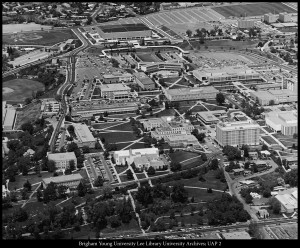[soundslides width=”620″ height =”503″ id=”194899″]
Plans to close Campus Drive as part of an initiative to make BYU more pedestrian-oriented ironically became public during a major winter storm that left sidewalks icy and the whole of campus anything but pedestrian friendly.
But the almost instant reaction to news of the 2013 Campus Unification Plan was not as much about pedestrians and the weather as it was about how the Campus Unification Project would affect on-campus parking.
Comments about the unification project on The Universe’s Facebook page were split, but animated, in a parking debate that has been raising the collective campus blood pressure for decades.
“The problems are many, and the solutions to some are complex and frustrating,” a former facilities director, Sam F. Brewster, wrote in response to a student’s questions. “While it may seem that the problem of parking has not been well handled, I can only assure you that some very capable people have worked long and hard on the problem and they will continue to do so.”
That extract is from a letter preserved in BYU’s archives that was written in 1970, which was a lively year for the parking debate. Also in the files is a letter from the College of Religious Instruction that called the administration’s position on parking inconveniences “inconsistent” with other sacrifices members of the faculty are asked to make.
Student Nathan Coulter wrote to then-BYU President Ernest L. Wilkinson: “On behalf of the thousands of students, we want to establish (an) equitable solution and work out a mutual benefit to all.”
Wilkinson showed little sympathy for complaints from faculty in a memo that says faculty members “have had it so easy with respect to parking close to their buildings that they have developed non-locomotion of the legs.”
A 1974 aerial photo of campus doesn’t show who could park where, but it does show a number of parking lots on the interior of campus that no longer exist: between the Brimhall Building and Joseph Smith Memorial buildings, between the BYU Bookstore and the Harold B. Lee Library and south of the Talmage Building, for example. New buildings sit on some of the former parking-lot space; grass or concrete designed for pedestrians covers others.

Redesigns that are part of the new unification project are expected to result in a cut in parking spots in the lot north of the Jesse Knight Building but a net gain overall with additional parking spaces in the lot north of the Museum of Art and next to the BYU Law School.
Todd Hollingshead, a University Communications spokesman, said the new Life Sciences building under construction on the south end of campus will include a parking structure with about 250 stalls. He also said other construction projects on campus have included the addition of new parking spots, like in the structure adjacent to the Tanner Building and the faculty lot under the Joseph F. Smith Building.
Hollingshead suggested students who spend time trolling lots for parking try the lots north of the Marriott Center or southeast of LaVell Edwards Stadium. He said the walk from those lots to campus will likely take less time than what students may spend looking for parking closer to the campus center.
“We want to promote a pedestrian friendly campus,” Hollingshead said.
Bob Ross is a member of BYU’s University Traffic Committee, which regularly reviews the best uses of on-campus parking. This committee is comprised of faculty members, student leaders, University Police and administrators. Ross said parking complaints or recommendations should be sent to the committee.




